For a printable version of newsletter click here.
For a printable version of newsletter with photos click here.
For a printable version of newsletter with photos click here.
UP RISE CITIES
The idea of a sojourn among her forebears’ places in Germany had appealed to Lena Lentz Hardt. It’d be a nice get-away from Lentz Spelt Farms on the Columbia Plateau where the winds blow hard in early spring. She wanted to walk in the same village where once strode her farmer relatives; she did that in Weinsbach, the Dorf where the Hausers lived in the 1700s before emigrating to Catherine the Great’s Russia. Lentz also has visited an abbey of stones hewn by her farmers in Fronarbeit service to church and count, and she saw stone-axed poles sunk into swamp, on a tour of the 12th-century Zisterzienser Monastery of Heilsbronn.
But where does it take her, this projection of herself back all those centuries? She’s cast into a world of demons and friars, wastrel counts and incantations...
Is that her, on fleet-footed animal rushing to a moonlit forest clearing for a wiccan convocation?
Is that her as girl searching for bela herb in the dark woods?
In one past lifetime, Lentz works alongside a farmer stout and astute, swinging scythe and yanking hoe, the milking a twice-daily chore, and then there is seemingly endless spinning and weaving to be done. Her mother had taught her shamanic intonations to defray the weariness of weaving, she hums them now.
In another life Lentz does the same farmwoman chores, but this time her man is a Leibeigene serf, as is she. It’s not the same, this life of labor with a body that you’re told doesn’t belong to yourself, while the church’s after your soul. She loves her man nevertheless.
Central to medieval experience is what historians always put so pat: “Big population increases occurred.” The fact is, the Middle Ages’ big population increase was women’s work, because back then the women bore the children. And more children. And more children.
But where does it take her, this projection of herself back all those centuries? She’s cast into a world of demons and friars, wastrel counts and incantations...
Is that her, on fleet-footed animal rushing to a moonlit forest clearing for a wiccan convocation?
Is that her as girl searching for bela herb in the dark woods?
In one past lifetime, Lentz works alongside a farmer stout and astute, swinging scythe and yanking hoe, the milking a twice-daily chore, and then there is seemingly endless spinning and weaving to be done. Her mother had taught her shamanic intonations to defray the weariness of weaving, she hums them now.
In another life Lentz does the same farmwoman chores, but this time her man is a Leibeigene serf, as is she. It’s not the same, this life of labor with a body that you’re told doesn’t belong to yourself, while the church’s after your soul. She loves her man nevertheless.
Central to medieval experience is what historians always put so pat: “Big population increases occurred.” The fact is, the Middle Ages’ big population increase was women’s work, because back then the women bore the children. And more children. And more children.
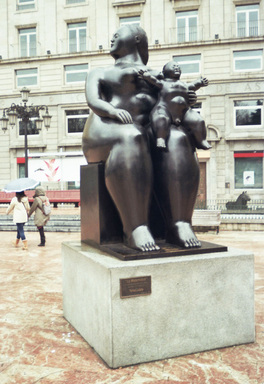
Risky business it was. As you felt the child grow inside, the old-crone midwife starts coming around, reeking of strange herbs and garlic. The man you’re with is concerned, considerate, yet also at a remove, the birth about to happen in the women’s sphere.
And then the time comes. It’s dark inside the house; not even counts can afford glass for windows, not even mullioned glass, and so the farmhouse windows are just that, “wind-eyes” through which blows breeze and gale. No wonder the holes are small in the wall. The floor is tamped dirt, the ceiling low. The open hearth smoke’s blackened the room over the years. A candle may be burning, perhaps an oil lamp, which in your condition distorts familiar objects like butter churn, carding tool, kettle. As your pains grow intense, the midwife mutters spells, forces you to drink a tea thick with revolting herbs brewed, but you gulp down the cure. Wolf howl sounds from the forest. Wherever your man is pacing, you don’t care.
You breathe, breathe, breathe, breathe until breath becomes conjuration, Frig-Holda!, oh Goddess come!, you who protect the birthing woman.
Child mortality rates are very high in the Middle Ages. It’s how nature arranges the survival of the fittest. About 20 percent of children died in their first year, only 70 percent reached the age of 20. Those who made it to 20 had a life expectancy of 50 to 55 years.
The population expanded until the begin of the 14th century, at which point German speakers on the continent counted about 15 million people: we must explain the cities.
And then the time comes. It’s dark inside the house; not even counts can afford glass for windows, not even mullioned glass, and so the farmhouse windows are just that, “wind-eyes” through which blows breeze and gale. No wonder the holes are small in the wall. The floor is tamped dirt, the ceiling low. The open hearth smoke’s blackened the room over the years. A candle may be burning, perhaps an oil lamp, which in your condition distorts familiar objects like butter churn, carding tool, kettle. As your pains grow intense, the midwife mutters spells, forces you to drink a tea thick with revolting herbs brewed, but you gulp down the cure. Wolf howl sounds from the forest. Wherever your man is pacing, you don’t care.
You breathe, breathe, breathe, breathe until breath becomes conjuration, Frig-Holda!, oh Goddess come!, you who protect the birthing woman.
Child mortality rates are very high in the Middle Ages. It’s how nature arranges the survival of the fittest. About 20 percent of children died in their first year, only 70 percent reached the age of 20. Those who made it to 20 had a life expectancy of 50 to 55 years.
The population expanded until the begin of the 14th century, at which point German speakers on the continent counted about 15 million people: we must explain the cities.
*****
As professor at Erlangen near Nürnberg, Stuart Jenks analyzes the medieval economy. He writes that the ways and means by which medieval cities developed had to do with the change in how merchants operated. Previously commerce had been the purview of wandering traders (who were predominantly Jewish); typically, the goods they traded were luxury items for the upper class. But now these merchants were settling down in cities, where they shifted their business to include commodities for the common people – they traded first the salt, then the salted fish, they had pelts and wax and honey transported, and cloth and wool and wine.
The settled merchants had to rely on a monetary system that included services of Wechsler, “changers” who turned foreign currency into local moneys. Jenks notes that at their earliest historical record these Wechsler already keep accounts for merchants, manage deposits, record debts and occasionally offer credit. Does this sound like bankers? Some of the first Wechsler documented did business in Genoa, Italy where they were called bancherii, which term’s derived from bancus, the writing “table” at which they did their work.
The settled merchants had to rely on a monetary system that included services of Wechsler, “changers” who turned foreign currency into local moneys. Jenks notes that at their earliest historical record these Wechsler already keep accounts for merchants, manage deposits, record debts and occasionally offer credit. Does this sound like bankers? Some of the first Wechsler documented did business in Genoa, Italy where they were called bancherii, which term’s derived from bancus, the writing “table” at which they did their work.
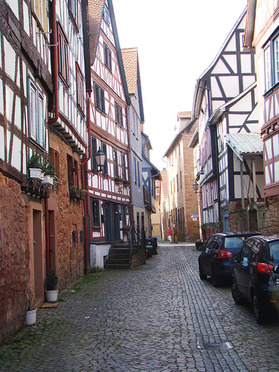
We wouldn’t be more wrong to view the city growth of commerce as a progression that could be expected in view of sharp population increases. No, it actually took quite a bit of mental wrangling for medieval folk to accept commerce with a money system more complex than the trading in the early local markets for farm goods. An enormous stigma loomed over merchants, a stigma embedded since old Rome, Jenks points out: like the Romans so did the early medieval clergy find it “ungodly” that money, an inert material after all, could multiply by way of credit and interest payments. Jenks quotes a church document that cites three reasons for decrying business: “First, the root of all trading is greed. Second, the businessman lies, deceives, gives wrong preferments, and cheats – out of necessity –, and therefore his soul is in danger. Third, the social effect of commerce is catastrophic.”
When the church relaxed this stance on business somewhat, from the 11th century on, various laws and proclamations kept up the condemnation of usury; nevertheless the overall standing of merchants lifted to where an economy in the modern sense could start developing between 1000 and 1250. Jenks declares this inceptive social acceptance of commerce as “a clear break with antiquity... Thereby one is justified in defining here the boundary of a new epoch.”
However, not until several centuries later would merchants be broadly accepted. As late as during the rise of protestantism in the 1500s, Martin Luther adhered to the original catholic negativity toward trade: “One can not lie about this, that buying and selling is a necessary thing which... is useful in a Christian way, especially the things of service in daily life and of honest use. For so have the patricians sold and bought livestock, wool, grain, butter, milk and other goods. They are God’s gifts from what the earth gives, divided between the people. But foreign (‘out-landish’) trade, which brings from Kalikut (Calcutta?) and India the same goods, such as delicate silks and gold jewelry and spices that serve only pomp and no other purpose, and suck the money from land and people, this should not be allowed where we have a city government (‘regiment’) or a prince.”
Historian Michael North comments: “Reason for this attack on international trade was the feared erosion of the class-structure society.”
When the church relaxed this stance on business somewhat, from the 11th century on, various laws and proclamations kept up the condemnation of usury; nevertheless the overall standing of merchants lifted to where an economy in the modern sense could start developing between 1000 and 1250. Jenks declares this inceptive social acceptance of commerce as “a clear break with antiquity... Thereby one is justified in defining here the boundary of a new epoch.”
However, not until several centuries later would merchants be broadly accepted. As late as during the rise of protestantism in the 1500s, Martin Luther adhered to the original catholic negativity toward trade: “One can not lie about this, that buying and selling is a necessary thing which... is useful in a Christian way, especially the things of service in daily life and of honest use. For so have the patricians sold and bought livestock, wool, grain, butter, milk and other goods. They are God’s gifts from what the earth gives, divided between the people. But foreign (‘out-landish’) trade, which brings from Kalikut (Calcutta?) and India the same goods, such as delicate silks and gold jewelry and spices that serve only pomp and no other purpose, and suck the money from land and people, this should not be allowed where we have a city government (‘regiment’) or a prince.”
Historian Michael North comments: “Reason for this attack on international trade was the feared erosion of the class-structure society.”
*****
It was exactly international trade that brought along with luxuries also new technologies to old Europe. During the pax mongolica – the peace treaty with Mongolian rulers who’d advanced to the Balkans in the 13th century – a brisk trade flourished along routes between China and Italy, Marco Polo’s family the best known of those adventurer-trader generations. Taking their cues from Genoa and Venice, German traders too formed merchant associations, the Hanse (Hanseatic League) in the north trading east-west along the Baltic and North Sea, merchants of southern German regions doing lots of business south-north across the Alps. The Slavs and Balts, meanwhile, kept trading north-south along the Amber Road.
An important Chinese technology was paper manufacture; the first Central European water-power paper mills date 13th century, just when the settling merchants relied on ever more paperwork in communicating with far-away warehouses and in keeping track of debt. Communication needs kept rising, so more clerks were in demand, which led to the organization of the schools that broke the church’s monopoly on education – the first German city-school opened its doors in Hansestadt Lübeck, 1252.
Even though Arabic numerals were known, the number zero confused in the non-decimal accounting of the era: Roman numerals were utilized for a surprisingly long time. The continued use of the abacus also had the advantage that the calculation on the counting frame was easily followed by witnesses, Jenks notes.
Money and measures varied incredibly; in a table for 1500 we find the following: 1 gulden = 15 batzen = 60 kreuzer; 1 pfund heller = 20 shillings heller = 240 pfennig heller; the conversion was approximately 1 gulden to 1.4 pfund heller. Land was measured in morgen or jauchert, 1 jauchert = 1.5 morgen which equals about 0.43 hectares / 1.2 acres. Grain was measured in barrels called malters which ranged from 150 to 180 liters per malter; alternately grain was traded in quarters which could range from a volume of 26 liters, all the way up to 161 liters.
As they settled in cities, the merchants turned time into a commodity, introducing mechanical clocks in the mid-1300s: “No longer rang the clocks the hour for prayer, but now measured the working hour.” Jenks notes that the Werksglocke, the “factory clock,” was resented by weavers so much that labor unrest erupted in areas where a textile industry was forming.
An important Chinese technology was paper manufacture; the first Central European water-power paper mills date 13th century, just when the settling merchants relied on ever more paperwork in communicating with far-away warehouses and in keeping track of debt. Communication needs kept rising, so more clerks were in demand, which led to the organization of the schools that broke the church’s monopoly on education – the first German city-school opened its doors in Hansestadt Lübeck, 1252.
Even though Arabic numerals were known, the number zero confused in the non-decimal accounting of the era: Roman numerals were utilized for a surprisingly long time. The continued use of the abacus also had the advantage that the calculation on the counting frame was easily followed by witnesses, Jenks notes.
Money and measures varied incredibly; in a table for 1500 we find the following: 1 gulden = 15 batzen = 60 kreuzer; 1 pfund heller = 20 shillings heller = 240 pfennig heller; the conversion was approximately 1 gulden to 1.4 pfund heller. Land was measured in morgen or jauchert, 1 jauchert = 1.5 morgen which equals about 0.43 hectares / 1.2 acres. Grain was measured in barrels called malters which ranged from 150 to 180 liters per malter; alternately grain was traded in quarters which could range from a volume of 26 liters, all the way up to 161 liters.
As they settled in cities, the merchants turned time into a commodity, introducing mechanical clocks in the mid-1300s: “No longer rang the clocks the hour for prayer, but now measured the working hour.” Jenks notes that the Werksglocke, the “factory clock,” was resented by weavers so much that labor unrest erupted in areas where a textile industry was forming.
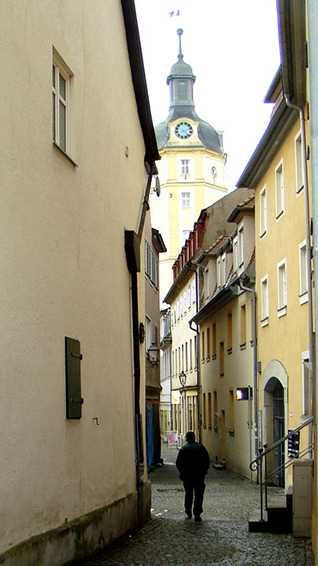
Yes, even the medieval had its industrialization (though rather small compared to the big one in the 19th century). Woolen cloth was widely manufactured, especially after the spinning wheel had been invented in the second half of the 13th century. Jenks writes that advanced labor division led to many job types in the fabric industries: weaver, walker, carder, shearer, dyer, spinner etc. When regional manufacturing centers formed, the industries developed independently from feudal land divisions. In Cologne, famous for its Kölner Tuch, some 20,000 wool cloths were manufactured annually by the mid-1300s.
The step from cottage-manufacture to mass-production also happened with linen and canvas, and by the late 1300s a cloth called Barchent became the leading fabric first around Lake Constance, then in Regensburg, Biberach, Augsburg, Ulm, Memmingen. Barchent (from Arabic barrakan) was a fabric that admixed the fiber of flax with cotton fiber, the cotton imported from Syria; Barchent took the dye better than linen did, and, Jenks writes, “the cloth feels comfortable on the skin, is warm in winter and soaks up the sweat in summer.” (Of industrially produced clothes’ fabric, Barchent would be the primary one in Europe up into the 1800s.)
Inventions of more water power technologies furthered industrial expansion. Not only were most flour mills and oil seed presses water-driven, now water-powered hammermills processed metals as well. Even wire was mechanically drawn at this early stage (although nails would be manually manufactured for several more centuries). Most importantly, much larger smelters were possible when big water-powered bellows were engineered, Jenks emphasizes. And, as mining shafts were driven ever deeper, ever more underground water had to be removed from the mines, which removal was also switched from horse-and-man- to water-power, buckets sewn from ox leather getting lifted out of the mines mechanically.
The step from cottage-manufacture to mass-production also happened with linen and canvas, and by the late 1300s a cloth called Barchent became the leading fabric first around Lake Constance, then in Regensburg, Biberach, Augsburg, Ulm, Memmingen. Barchent (from Arabic barrakan) was a fabric that admixed the fiber of flax with cotton fiber, the cotton imported from Syria; Barchent took the dye better than linen did, and, Jenks writes, “the cloth feels comfortable on the skin, is warm in winter and soaks up the sweat in summer.” (Of industrially produced clothes’ fabric, Barchent would be the primary one in Europe up into the 1800s.)
Inventions of more water power technologies furthered industrial expansion. Not only were most flour mills and oil seed presses water-driven, now water-powered hammermills processed metals as well. Even wire was mechanically drawn at this early stage (although nails would be manually manufactured for several more centuries). Most importantly, much larger smelters were possible when big water-powered bellows were engineered, Jenks emphasizes. And, as mining shafts were driven ever deeper, ever more underground water had to be removed from the mines, which removal was also switched from horse-and-man- to water-power, buckets sewn from ox leather getting lifted out of the mines mechanically.
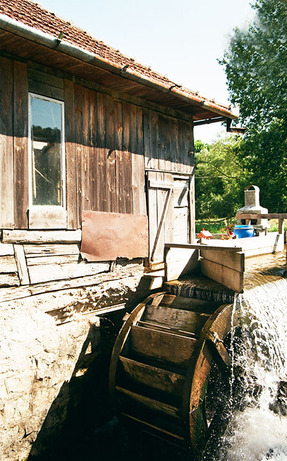
Since water power is limited to location, deforestation near fast-flowing streams led to a new profession, the collier who burned charcoal that then had to be transported to the smelters. “Already in 1185 one hears in the Etsch region (in the Alps) of independent colliers who employed their own teamsters,” Jenks notes.
If on one hand the demand for iron, copper and other ore kept steadily increasing, on the other hand the moneys required for mine expansion could no longer be raised by the groups of miners who worked their claim independently. Jenks describes the first instance of “division of capital and labor” in German-speaking lands: the miners of Rammelsberg near Goslar (Lower Saxony) had to give up their independent mining when they couldn’t afford the technology necessary for deeper shafts. “The Goslar burghers who advanced the miners the money had before the (capital-providing) contract nothing whatsoever to do with mining, nor did they participate in the mining operation afterwards – they were solely givers of capital (and now owners in the mine) who shared profits and losses, while the up-to-then self-employed... Rammelsberger miners became dependent on wages.” The year is 1407. By 1418 capital had to be obtained from outside the region to keep the mine going, some of that investment came from Walkenried Abbey in the Harz Mountains (northern Germany). By the end of the 15th century, capital from merchants in faraway Nürnberg and Leipzig further spread out the Rammelsberg Mine ownership.
If on one hand the demand for iron, copper and other ore kept steadily increasing, on the other hand the moneys required for mine expansion could no longer be raised by the groups of miners who worked their claim independently. Jenks describes the first instance of “division of capital and labor” in German-speaking lands: the miners of Rammelsberg near Goslar (Lower Saxony) had to give up their independent mining when they couldn’t afford the technology necessary for deeper shafts. “The Goslar burghers who advanced the miners the money had before the (capital-providing) contract nothing whatsoever to do with mining, nor did they participate in the mining operation afterwards – they were solely givers of capital (and now owners in the mine) who shared profits and losses, while the up-to-then self-employed... Rammelsberger miners became dependent on wages.” The year is 1407. By 1418 capital had to be obtained from outside the region to keep the mine going, some of that investment came from Walkenried Abbey in the Harz Mountains (northern Germany). By the end of the 15th century, capital from merchants in faraway Nürnberg and Leipzig further spread out the Rammelsberg Mine ownership.
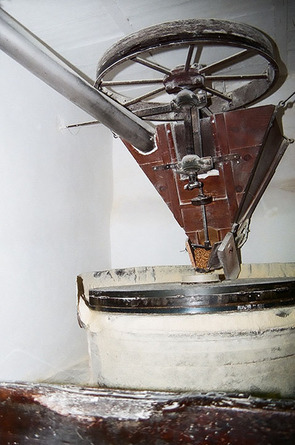
The next step in the split of capital from labor occurred in Saxony and Bohemia, where mines were self-financed by Kuxe, miners unions that operated on a four-way partnership. As financial pressures of new technologies compounded, these Kuxe were increased to 32 shares, then to 128 shares that were held by persons far from the mine. Eventually even fractions of a Kux were traded – in 1480 a half-Kux sold for the princely sum of 1000 Gulden. One particular significance of the Kuxen was that a big range of investors could get involved: “... from princes and nobility... to independent craftsmen, widows and orphans, with the exception of farmers...” Thereby unprecedented amounts of capital became available for mine expansion, Jenks elaborates. Also unprecedented was that the Kuxen could be transferred without permission from the other shareholders. At the Leipzig and the Frankfurt Messe (“trade fair exhibition”) you could buy and sell these shares. “Thus capital was separated from labor not only industrially but also spatially.”
There you have it, banking and stock markets sprout in the Middle Ages. As does the urban scape of what will become Germany: instead of large, concentrated population centers, German cities grow like mushrooms, everywhere. Jenks remarks that as late as mid-15th century only 25 German cities numbered over 10,000 inhabitants, while 95 percent of the cities had a population of less than 2000. “This is evidence that the distinction between city and village (had become) relatively fluid.”
There you have it, banking and stock markets sprout in the Middle Ages. As does the urban scape of what will become Germany: instead of large, concentrated population centers, German cities grow like mushrooms, everywhere. Jenks remarks that as late as mid-15th century only 25 German cities numbered over 10,000 inhabitants, while 95 percent of the cities had a population of less than 2000. “This is evidence that the distinction between city and village (had become) relatively fluid.”
*****
For another perspective (from other sources) on medieval teutonic cities, Lentz visits Worms. First a taxi ride to the Rhein, the mighty river who saw so much prehistory and history and myths along its banks and flanks – Celtic tribes crossing, St Hildegard composing treatises on “healing grain” spelt, the spurned-woman Lorelei luring sailors to their deaths in the rapids while murmuring dark-water sounds as she combs her long hair. Lentz photographs the statue of Hagen in his rowboat, caught at the moment when he lets the golden treasure of the Nibelungen slide from his upturned shield where the river runs deepest, so that Attila the Hun would never find it. (And neither would the thousands of treasure seekers who comb the former river beds around Worms to this day, just as American gold hunters flock to the Superstition Mountains in Arizona for the Lost Dutchman’s mine, in vain.)
From the Rhein a trail leads Lentz into a maze of narrow lanes contrasting the street-layout of old city – she walks through Gassen not Strassen, lanes so narrow, elsewhere they’d be alleys. The houses are built low, the Gassen curving: this was once the fishermen’s quarter of Worms.
From the Rhein a trail leads Lentz into a maze of narrow lanes contrasting the street-layout of old city – she walks through Gassen not Strassen, lanes so narrow, elsewhere they’d be alleys. The houses are built low, the Gassen curving: this was once the fishermen’s quarter of Worms.
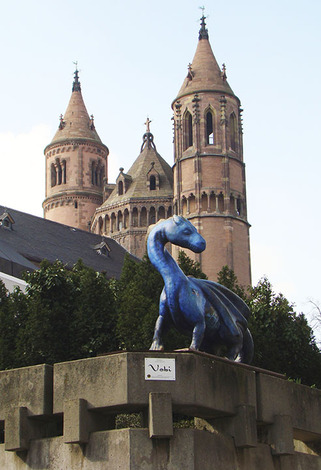
We’re on the way to see the Wormser Dom, the renowned medieval cathedral where Bishop Burchard tore his hair out over animist chanting in German forest (as we reported last month). We’ll stroll by a million postcards of the Dom and of the bishop’s statue, we’ll walk by the remaining city wall where gobs of tourists take their picture. But it’s here, here in this small and plain fishermen’s quarter where no Kaiser ever set foot, that history was made just as important as in cathedral and palace: our story of cities shall tell of their inhabitants’ courage when fighting for their rights.
The nobles didn’t know what to think when the first cities grew. Where there had been but a watermill, soon a cluster of houses congregated seemingly out of nowhere, and folks started trading food stuffs for handmades. Of course it wasn’t long before aristocracy and church figured out ways to derive income from, and gain control over, the phenomenon city. There would be a lord over each city – frequently a bishop –, and the city would have to pay for its rights.
As population increases soared, three city types established themselves. The market town, with very few rights. The territorial town with varying extent of rights, depending on its count or bishop. And, the imperial city, such as Worms, Nürnberg, Dinkelsbühl, whose burghers received broad-range rights directly from the Kaiser.
The main privileges that townspeople desired were the right to build a fortification wall; the right to collect toll and tax; the right to mint coins.
The nobles didn’t know what to think when the first cities grew. Where there had been but a watermill, soon a cluster of houses congregated seemingly out of nowhere, and folks started trading food stuffs for handmades. Of course it wasn’t long before aristocracy and church figured out ways to derive income from, and gain control over, the phenomenon city. There would be a lord over each city – frequently a bishop –, and the city would have to pay for its rights.
As population increases soared, three city types established themselves. The market town, with very few rights. The territorial town with varying extent of rights, depending on its count or bishop. And, the imperial city, such as Worms, Nürnberg, Dinkelsbühl, whose burghers received broad-range rights directly from the Kaiser.
The main privileges that townspeople desired were the right to build a fortification wall; the right to collect toll and tax; the right to mint coins.
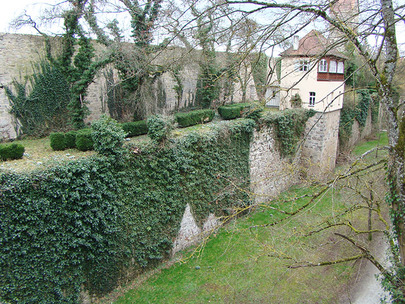
Merchants made up the upper core of cities. They were outnumbered by the craftsmen of whom there were carpenters, tailors, leather craftsmen, smiths, masons, millers, bakers, candle-makers, wheelwrights, weavers, etc. etc. In mid-1300s Nürnberg, for example, 71 Knochenhauer (literally: “bone-thrashers,” i.e., butchers) had shops. And in the river towns like Worms lived fishermen as well.
The merchants were the most vulnerable, their fortunes the biggest for plunder in war. And many wars, much strife wracked medieval lands, because nobility and church were almost constantly fighting for preeminence. The worst conflicts ensued when the succession of Kaiser or pope was challenged. Too many nobles wanted to wear a crown and were willing to fight war for it if intrigue didn’t get them the throne. No thought was given to cities and villages that laid in the way of armies.
Alas, there came a point when burghers learned to turn feuds between lords to their own advantage. It happened in Worms, in the first instance.
Disclaimer: Northern Italy and France were culturally and economically far ahead of Germany, and also led in matters of social change. So when we discuss what the burghers of Worms set in motion on teutonic soil, we must acknowledge that cities like Cremona and Le Mans had set precedent.
What did the medieval burghers want, beyond the above-mentioned rights? Simply self-determination. Today it’s considered a self-evident truth, but back in the Middle Ages thoughts of citizen freedom had to be wrung from the seemingly eternal order that had been inculcated by church and nobility – you belong to those who reign, you live by their rules and theirs alone. It took new thought and initiative to even speculate on an order different.
To execute social change usually meant risking your neck because without violence the lords and clerics wouldn’t budge, but rarely. The citizens of Cremona drove their bishop out of the city and destroyed his castle and houses, refused to render taxes, started logging bishopric forests, and laid their hands on church properties. When Le Mans rose up, their revolt was beaten down brutally.
In Worms the burghers saw their chance to achieve some of their ends when King Heinrich IV was engaged in a fight against the princes of Saxony and Thuringia. Knowing that the Wormser bishop sided with the princes, the burghers offered the king safe haven in their city. Ironically, Worms was a particularly defensible city because only a few decades earlier, Bishop Burchard – yes, here he is again – had further buttressed the already tall city walls. The king also received adequate food supplies from the burghers, and they gave him moneys and military support. Guess what: to the great chagrin of the bishop, the king rewarded the Wormser by exempting them from toll at royal road stations.
It was a small step forward for German cities. The first little freedom leap.
The merchants were the most vulnerable, their fortunes the biggest for plunder in war. And many wars, much strife wracked medieval lands, because nobility and church were almost constantly fighting for preeminence. The worst conflicts ensued when the succession of Kaiser or pope was challenged. Too many nobles wanted to wear a crown and were willing to fight war for it if intrigue didn’t get them the throne. No thought was given to cities and villages that laid in the way of armies.
Alas, there came a point when burghers learned to turn feuds between lords to their own advantage. It happened in Worms, in the first instance.
Disclaimer: Northern Italy and France were culturally and economically far ahead of Germany, and also led in matters of social change. So when we discuss what the burghers of Worms set in motion on teutonic soil, we must acknowledge that cities like Cremona and Le Mans had set precedent.
What did the medieval burghers want, beyond the above-mentioned rights? Simply self-determination. Today it’s considered a self-evident truth, but back in the Middle Ages thoughts of citizen freedom had to be wrung from the seemingly eternal order that had been inculcated by church and nobility – you belong to those who reign, you live by their rules and theirs alone. It took new thought and initiative to even speculate on an order different.
To execute social change usually meant risking your neck because without violence the lords and clerics wouldn’t budge, but rarely. The citizens of Cremona drove their bishop out of the city and destroyed his castle and houses, refused to render taxes, started logging bishopric forests, and laid their hands on church properties. When Le Mans rose up, their revolt was beaten down brutally.
In Worms the burghers saw their chance to achieve some of their ends when King Heinrich IV was engaged in a fight against the princes of Saxony and Thuringia. Knowing that the Wormser bishop sided with the princes, the burghers offered the king safe haven in their city. Ironically, Worms was a particularly defensible city because only a few decades earlier, Bishop Burchard – yes, here he is again – had further buttressed the already tall city walls. The king also received adequate food supplies from the burghers, and they gave him moneys and military support. Guess what: to the great chagrin of the bishop, the king rewarded the Wormser by exempting them from toll at royal road stations.
It was a small step forward for German cities. The first little freedom leap.
*****
In general, the cities advanced the concept of Kommune, a community that governs itself. In the case of Worms, and also Köln (Cologne, also on the Rhine), the burghers organized themselves loosely, temporarily, they did not form a coniuratio, a sworn conspiracy. But that’s what happened in many other cities before long; one manifestation of sworn conspiracy was the Eidgenossenschaft, the “oath fellowship” which defined itself as a confederation of equals (as opposed to the oath of fealty to a lord). Some of the Eidgenossenschaften that began forming in the 13th century would develop into the independent Switzerland, Europe’s only democracy as we know it today.
As you can imagine, the push to Kommunen didn’t sit well with clergy and aristocracy. The Zisterzienser abbott Bernhard von Clairvaux called the Kommune concept “turmoil and godlessness.” Abbott and historian Guibert von Nogent wrote that Kommune “is a totally horrible term.” He’s quite direct in explaining why he thinks that: “...it gives the people who until this point have been dependent (on church and nobility), the opportunity... to put into question the god-given dominance of lords.”
God-given or not, lording it over cities entitled nobility and church to outrageous demands. In Köln the citizen revolt (one year after the initial events in Worms) was sparked on Easter 1074 by the archbishop Anno von Köln. Anno had the bishop of Münster over for a visit; for his guest’s return journey, Anno appropriated a merchant’s river boat that was already loaded with wares for a trading trip. Accusing Anno of “tyrannical hubris,” the people rose in response. King Heinrich IV did not come to the aid of the Kölner, so Bishop Anno could slap down the revolt. But the Kommune concept received added attention in neighboring cities.
As you can imagine, the push to Kommunen didn’t sit well with clergy and aristocracy. The Zisterzienser abbott Bernhard von Clairvaux called the Kommune concept “turmoil and godlessness.” Abbott and historian Guibert von Nogent wrote that Kommune “is a totally horrible term.” He’s quite direct in explaining why he thinks that: “...it gives the people who until this point have been dependent (on church and nobility), the opportunity... to put into question the god-given dominance of lords.”
God-given or not, lording it over cities entitled nobility and church to outrageous demands. In Köln the citizen revolt (one year after the initial events in Worms) was sparked on Easter 1074 by the archbishop Anno von Köln. Anno had the bishop of Münster over for a visit; for his guest’s return journey, Anno appropriated a merchant’s river boat that was already loaded with wares for a trading trip. Accusing Anno of “tyrannical hubris,” the people rose in response. King Heinrich IV did not come to the aid of the Kölner, so Bishop Anno could slap down the revolt. But the Kommune concept received added attention in neighboring cities.
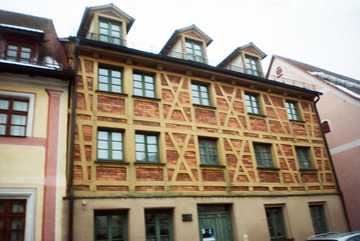
Back to Worms. The last Kaiser of the Salian dynasty, Heinrich V, would remember the help the Wormser had given his father. He granted the burghers the right to free marriage, and, extremely important, the right to inheritance. Today it may seem inconceivable that you couldn’t pass on your belongings to your offspring, but that had been the privilege of only the aristocracy for centuries. (Although, many agrarians did get to farm their father’s land, simply because it was convenient for the count to let the son continue on the late father’s farm.)
The new inheritance rights meant that the Wormser were no longer exposed to a crippling death tax. Eventually the system of Leibeigene serfs was also abolished, but only inside the city walls. A little later, as Staufen and Welfen fought it out over who’d become the next Kaiser, Worms insisted on forming a Kommune, and by the beginning of the 13th century they finally had their autonomy – Ratsherren from their own ranks formed a Stadtrat (Rat, the ‘a’ pronounced as in “guard,” means councillor; Stadtrat = city council). In a very short time the Wormser Rathaus went up, a proud city hall.
Across Germany the Kommune movement of cities mounted a long struggle with many, many lost lives along the way. So when a city achieved its rights to govern and built its Rathaus, the burghers made sure that their Rathaus rivaled church and count’s palace in magnificence. Today the Rathaus of almost every major German city is a tourist draw for its imposing architecture. And of course there is always a mechanical clock in the tower.
The new inheritance rights meant that the Wormser were no longer exposed to a crippling death tax. Eventually the system of Leibeigene serfs was also abolished, but only inside the city walls. A little later, as Staufen and Welfen fought it out over who’d become the next Kaiser, Worms insisted on forming a Kommune, and by the beginning of the 13th century they finally had their autonomy – Ratsherren from their own ranks formed a Stadtrat (Rat, the ‘a’ pronounced as in “guard,” means councillor; Stadtrat = city council). In a very short time the Wormser Rathaus went up, a proud city hall.
Across Germany the Kommune movement of cities mounted a long struggle with many, many lost lives along the way. So when a city achieved its rights to govern and built its Rathaus, the burghers made sure that their Rathaus rivaled church and count’s palace in magnificence. Today the Rathaus of almost every major German city is a tourist draw for its imposing architecture. And of course there is always a mechanical clock in the tower.
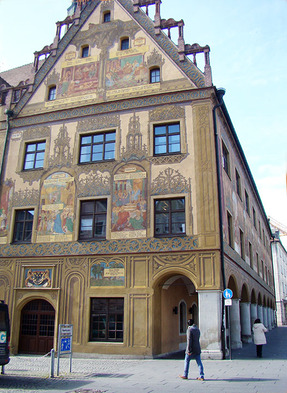
Meanwhile, what about those Wormser fish sellers, down in that quarter of small Gassen? They agitated for the right to form an association that could bargain collectively, and they were granted that right in 1106. Their organization was similar to a guild, a forerunner of sorts to the many guilds that will mold themselves into forces of many future uprisings – the people were learning to speak with one voice.
And now that you’ve read so much about Worms, we’ll let you in on the pronunciation: the ‘o’ in Worms sounds like that in Oliver.
And now that you’ve read so much about Worms, we’ll let you in on the pronunciation: the ‘o’ in Worms sounds like that in Oliver.
*****
Lentz in Worms, wondering what the historical complexities of cities’ growth have to do with the theme of her journey, the 1000 years of teutonic farming before her forebears wandered off to Russia. The answer is simple – everything connects, we shall see. Just think: no farmer without city cousins...
But before we get to farmer fate in those high medieval times, one more defining element of the steep population increases: by 1400, a full third of the population was superfluous, according to Jenks. There was no work for every third person, not even as Leibeigener serf was there a place in the economy despite its fast-paced growth.
This we must keep in mind when we’re talking about the great mobility which marks the era. Whereas the original village, the Dorf of the 8th and 9th century, held its people in place by social structure of an almost exclusively agrarian economy, the High Middle Ages plunge the population into a swirl that propels some individuals to a climbing status, while others lose themselves to drift. (Only the structural changes of the Late Middle Ages created opportunities for growth without a large part of the people succumbing to impoverishment, Jenks writes.)
In exploring her 1200-years-ago persona, Lentz had to split her family tree roots into free farmers and Leibeigene serfs. Four centuries later, however, the thread becomes forever more frayed.
The Dorf itself takes on several possible shapes by then: in addition to the original Dorf – a group of a dozen families clearing forest for several Gewanne of fields and common land for grazing, and then building their defensible Dorf, in a huddle –, a Dorf now can be a Weiler – a hamlet of very few farmsteads –, or a Haufendorf – a village “heap” almost city-size –, or a Strassendorf where the farmhouses don’t cluster but string out along a road, or an Angerdorf that’s basically a Strassendorf but at its center widens to provide space for church, village pond, and a plaza for public gatherings; lastly, now you also had the Hufendorf where the farmsteads were built at distance from one another.
But before we get to farmer fate in those high medieval times, one more defining element of the steep population increases: by 1400, a full third of the population was superfluous, according to Jenks. There was no work for every third person, not even as Leibeigener serf was there a place in the economy despite its fast-paced growth.
This we must keep in mind when we’re talking about the great mobility which marks the era. Whereas the original village, the Dorf of the 8th and 9th century, held its people in place by social structure of an almost exclusively agrarian economy, the High Middle Ages plunge the population into a swirl that propels some individuals to a climbing status, while others lose themselves to drift. (Only the structural changes of the Late Middle Ages created opportunities for growth without a large part of the people succumbing to impoverishment, Jenks writes.)
In exploring her 1200-years-ago persona, Lentz had to split her family tree roots into free farmers and Leibeigene serfs. Four centuries later, however, the thread becomes forever more frayed.
The Dorf itself takes on several possible shapes by then: in addition to the original Dorf – a group of a dozen families clearing forest for several Gewanne of fields and common land for grazing, and then building their defensible Dorf, in a huddle –, a Dorf now can be a Weiler – a hamlet of very few farmsteads –, or a Haufendorf – a village “heap” almost city-size –, or a Strassendorf where the farmhouses don’t cluster but string out along a road, or an Angerdorf that’s basically a Strassendorf but at its center widens to provide space for church, village pond, and a plaza for public gatherings; lastly, now you also had the Hufendorf where the farmsteads were built at distance from one another.
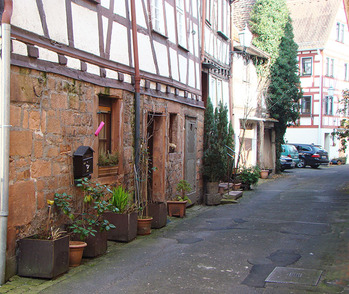
The social village structure also had changed, no longer was the village a community of solely farmers and Leibeigene serfs, but included lower classes of steady-hand farm workers who lived with the farmer family on farmstead, and seasonal farm workers – day laborers – who lived in huts at village edge, side by side with the Dienstboten who hired out for light services such as delivering packages and standing in when the count hosted a big event. And, in one part of the village now lived the Söldner, cottagers, some of whom had claim on just enough land to scrape by as small-time farmers, and others with not enough land to support themselves agriculturally but who made their living primarily from a cottage industry such as weaving, box making, etc. (Note: the term Söldner has two meanings, the primary one “mercenary soldier,” but in the context of South German villages, Söldner means “cottager” and has nothing to do with the military.)
Especially the lower classes in the villages felt the lure of the city. Most Neubürger (“new burghers”) came from nearby locations; by the early 14th century when family names were made uniform, the Neubürgerbücher document that of new arrivals in the city over 85 percent came from a distance of less than 60 miles away (this can be deducted from the place names the new arrivals chose for their family name, as in “Gerd from Minden in Lübeck.”)
The newcomers had to fit into the city class structure that had developed. In Nürnberg, for example, the “honorable” consisted of persons who derived income from land rents, commercially viable real estate, wholesale merchandizing, or who belonged to one of the highly regarded professions such as jurist, doctor, overseeing clerk. Their documents were written on parchment, everyone else’s on paper.
Excluded from the “honorable” were all who worked with their hands, the craftspeople, and also retailers.
Among the “not-honorable” we find workers and professionals who handle blood and dirt, the tanners, bathhouse personnel, barbers, as well as sheepherders, street sweepers, stream/canal cleaners, tower guards. And, millers (Jenks offers no explanation why millers rated so lowly). Other persons regarded as “not-honorable” were those who performed low-ranking public services, the hangmen, gravediggers, court servants, and those whose job it was to divvy up resources designated for the poor, or, rather, for those of the poor the city council had declared worthy of support.
At bottom social rung existed that third who were superfluous, Dirnen – loose women and prostitutes –, Spielleute – gamblers and street performers –, fahrendes Volk – the vagabonds and bands of roving people –, and the mass of children born out of wedlock.
The percentages of these social classes varied greatly form city to city, Jenks remarks. In the Hanse cities the merchants made up 12 to 22 percent of the population, middle-class craftsmen 30 to 45 percent, while the lower class seldom exceeded 50 percent and the poor made up less than 15 percent. In contrast, in 1475 Ausgburg the upper class claims only 8.5 percent, the middle class only 5 percent, while the lower classes and poor top 85 percent. Jenks emphasizes that the South German cities with manufacturing as their economic base, were considerably more exposed to social polarization than the Upper German merchant towns where wine and grain were the main trade goods.
Especially the lower classes in the villages felt the lure of the city. Most Neubürger (“new burghers”) came from nearby locations; by the early 14th century when family names were made uniform, the Neubürgerbücher document that of new arrivals in the city over 85 percent came from a distance of less than 60 miles away (this can be deducted from the place names the new arrivals chose for their family name, as in “Gerd from Minden in Lübeck.”)
The newcomers had to fit into the city class structure that had developed. In Nürnberg, for example, the “honorable” consisted of persons who derived income from land rents, commercially viable real estate, wholesale merchandizing, or who belonged to one of the highly regarded professions such as jurist, doctor, overseeing clerk. Their documents were written on parchment, everyone else’s on paper.
Excluded from the “honorable” were all who worked with their hands, the craftspeople, and also retailers.
Among the “not-honorable” we find workers and professionals who handle blood and dirt, the tanners, bathhouse personnel, barbers, as well as sheepherders, street sweepers, stream/canal cleaners, tower guards. And, millers (Jenks offers no explanation why millers rated so lowly). Other persons regarded as “not-honorable” were those who performed low-ranking public services, the hangmen, gravediggers, court servants, and those whose job it was to divvy up resources designated for the poor, or, rather, for those of the poor the city council had declared worthy of support.
At bottom social rung existed that third who were superfluous, Dirnen – loose women and prostitutes –, Spielleute – gamblers and street performers –, fahrendes Volk – the vagabonds and bands of roving people –, and the mass of children born out of wedlock.
The percentages of these social classes varied greatly form city to city, Jenks remarks. In the Hanse cities the merchants made up 12 to 22 percent of the population, middle-class craftsmen 30 to 45 percent, while the lower class seldom exceeded 50 percent and the poor made up less than 15 percent. In contrast, in 1475 Ausgburg the upper class claims only 8.5 percent, the middle class only 5 percent, while the lower classes and poor top 85 percent. Jenks emphasizes that the South German cities with manufacturing as their economic base, were considerably more exposed to social polarization than the Upper German merchant towns where wine and grain were the main trade goods.
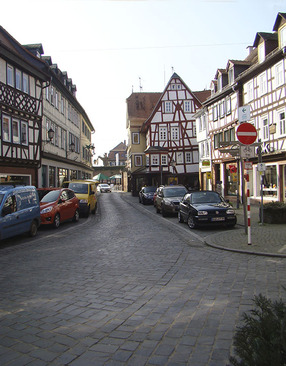
As for the well-off merchants, in time they will form the patrician class – after the old Roman model –, and build the famous patrician houses with winches at the tall gables. In the Stadtrat, relatively early, they will put in place industry regulations that control the quality of manufactured goods – they realized that uniformity helps sell a brand such as Kölner Tuch –, and they’ll limit trade routes to their own industries’ benefit. In Köln they even go so far as to forbid transport of city horse dung to lands other than those owned by Kölner burghers.
*****
The great mobility of the High Middle Ages also comes to the surface in church documents that have to do with the until-death-do-us-part innovation. When the church declared marriage a sacrament in 1184, it insisted on “consent matrimony,” that is, a marriage that’s valid when the two spouses-to-be consent, even against the wishes/commands of their families or superiors. This did not sit well with the aristocrats who still thought of marriage as a contract linked to inheritances, and who therefore felt “ambivalent” about the new sacrament.
The common folk, after the church did a bit of legal wrangling in regard to property derived from wages, were given the green light for holy matrimony in the late 1300s. But that didn’t stabilize gender relations as the church had hoped. “In the 15th century the courts that upheld church rules (canon law) experienced an overload of cases brought by women whose husbands did not honor their marriage vows,” one historian explains. Even though the courts decided almost always in favor of the woman, the bishops were at a loss of how to track down all these men who’d moved to another region to marry some other girl there – folks just moved around too much for keeping track. As for the spurned first wife, since the church would not give her a divorce she often lived in common-law marriage with another local man. From the perspective of the church, “this created a scandalous situation for the community.”
At around the same time the church also began to demand celibacy from its priests. The point was to draw an ever clearer line between priesthood and laity.
Neither celibacy by priests, nor holy matrimony by aristocrat, burgher, common man was widely accepted, not for many generations. In particular, marriage of Leibeigene serfs without the lord’s consent was still firmly opposed by the nobles. And due to this widespread rejection of the church’s marriage sacrament, the concubinary aspect of medieval society actually widened – just the opposite of what the church had hoped to achieve. Not until the 16th century would matrimony attain average status, and then only for “middle-aged people.”
But we got ahead of ourselves a little here, our storyline still approaches that second milestone date of the Middle Ages, October 1347.
The common folk, after the church did a bit of legal wrangling in regard to property derived from wages, were given the green light for holy matrimony in the late 1300s. But that didn’t stabilize gender relations as the church had hoped. “In the 15th century the courts that upheld church rules (canon law) experienced an overload of cases brought by women whose husbands did not honor their marriage vows,” one historian explains. Even though the courts decided almost always in favor of the woman, the bishops were at a loss of how to track down all these men who’d moved to another region to marry some other girl there – folks just moved around too much for keeping track. As for the spurned first wife, since the church would not give her a divorce she often lived in common-law marriage with another local man. From the perspective of the church, “this created a scandalous situation for the community.”
At around the same time the church also began to demand celibacy from its priests. The point was to draw an ever clearer line between priesthood and laity.
Neither celibacy by priests, nor holy matrimony by aristocrat, burgher, common man was widely accepted, not for many generations. In particular, marriage of Leibeigene serfs without the lord’s consent was still firmly opposed by the nobles. And due to this widespread rejection of the church’s marriage sacrament, the concubinary aspect of medieval society actually widened – just the opposite of what the church had hoped to achieve. Not until the 16th century would matrimony attain average status, and then only for “middle-aged people.”
But we got ahead of ourselves a little here, our storyline still approaches that second milestone date of the Middle Ages, October 1347.
*****
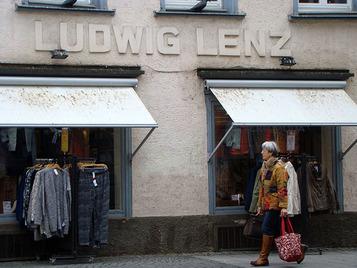
Ah, Lentz, what will you envision now? At the start of this chapter we had you give birth in a dark and smoky farmstead. Let’s say this baby were your third son to survive, who’d be leaving when grown; wouldn’t you send him on his way with his favorite Semmeln, the baked rolls he so loves, wouldn’t you also add some links of the best sausage to his little traveling bundle on the shoulder? Of course you would, wiping away a tear.
Maybe he’d be lucky with his talent and end up apprenticing with a tailor: in today’s Ulm, in fact, Lentz photographs the storefront of a clothing shop “Lenz.”
Maybe he’d be lucky with his talent and end up apprenticing with a tailor: in today’s Ulm, in fact, Lentz photographs the storefront of a clothing shop “Lenz.”

Maybe he’d fare farther and become a wheelwright, and have a city lane named after his family, like the “Hardtgasse” in today’s Worms.
Maybe he’d learn carpentry from a master, and specialize in building coaches later in life – in Friolsheim you find a “Benzinger” car dealership today.
Or maybe he’d join roving forest bandits, or toot a flute in a street musicians’ ensemble, or maybe he’d tame a bear cub and dance with the beast before gawking burghers.
Maybe, too, he’d end his life in some city as beggar. Such fate when older would be likely in many of the high medieval scenarios, so sadly...
On the upside, it’s realistic to imagine a straight line of first-born sons who farmed their father’s fields: in a lot of respects it was a good era for agrarians. Agricultural expansion was steady, new forest clearings opening up new farm ground, speak: opportunity for generations of farmers’ second sons. This was also the time when young farmers were encouraged to participate in the Ostsiedelung – “settlement of the East” –, the teutonic bid to take over lands belonging to Slavic and Baltic peoples.
Since medieval agriculture could not keep up with food demand of the three-century population growth from one person per square kilometer to ten – many a “hunger year” stands in the record –, grain prices rose, tripling between 1200 and 1350. Farmers were pressured to up their grain production: Vergetreidung is Jenks’ term, which one might translate as “accentuation-of-grain.” Some regions made it compulsory that farmers put all their strips of field in grain, rye mostly, but spelt and emmer in southern Germany.
In the big picture this meant a decrease of meat production because now less land was available to raise livestock feeds. Even after production shift to largely grain for human consumption, the needs of the population growth were not met. At a 3 percent yearly increase, the population doubled every quarter century – agriculture just couldn’t keep up.
But yields did bump up slowly, thanks to technological advances: the Kummet, the harness that optimizes a horse’s drawing power, appeared in Europe, considerably adding area to the spread of land a farmer could work (the Chinese had invented this type of harness 500 years earlier). The horseshoe came into use, albeit slowly because iron was still a rare commodity; as late as by end of the 11th century, a shod horse fetched twice the price of one not wearing horseshoes. And a new plow was introduced from the River Po plain of Italy; early medieval plows had been hook-shaped, merely scratching the soil, whereas the wheeled moldboard plow with its big plowshare turned the soil thoroughly. These new plows further increased the land area a farmer could till. The invention of the disc, meanwhile, also contributed to better yields in that discing alleviated some of the soil compaction where livestock grazed on stubble. And on the threshing floor the new, elongated threshing flail served more efficiently.
Jenks also writes of a diversification wave in farming, fenced “gardens” – row-crop acres, really, plus orchards and berry acres – producing fruits and vegetables for the cities. But this is where we must add question marks: elsewhere we find it noted that such row-crop “gardens” were not part of the landscape until centuries later – who to believe, historian or geobotanist?
Or maybe he’d join roving forest bandits, or toot a flute in a street musicians’ ensemble, or maybe he’d tame a bear cub and dance with the beast before gawking burghers.
Maybe, too, he’d end his life in some city as beggar. Such fate when older would be likely in many of the high medieval scenarios, so sadly...
On the upside, it’s realistic to imagine a straight line of first-born sons who farmed their father’s fields: in a lot of respects it was a good era for agrarians. Agricultural expansion was steady, new forest clearings opening up new farm ground, speak: opportunity for generations of farmers’ second sons. This was also the time when young farmers were encouraged to participate in the Ostsiedelung – “settlement of the East” –, the teutonic bid to take over lands belonging to Slavic and Baltic peoples.
Since medieval agriculture could not keep up with food demand of the three-century population growth from one person per square kilometer to ten – many a “hunger year” stands in the record –, grain prices rose, tripling between 1200 and 1350. Farmers were pressured to up their grain production: Vergetreidung is Jenks’ term, which one might translate as “accentuation-of-grain.” Some regions made it compulsory that farmers put all their strips of field in grain, rye mostly, but spelt and emmer in southern Germany.
In the big picture this meant a decrease of meat production because now less land was available to raise livestock feeds. Even after production shift to largely grain for human consumption, the needs of the population growth were not met. At a 3 percent yearly increase, the population doubled every quarter century – agriculture just couldn’t keep up.
But yields did bump up slowly, thanks to technological advances: the Kummet, the harness that optimizes a horse’s drawing power, appeared in Europe, considerably adding area to the spread of land a farmer could work (the Chinese had invented this type of harness 500 years earlier). The horseshoe came into use, albeit slowly because iron was still a rare commodity; as late as by end of the 11th century, a shod horse fetched twice the price of one not wearing horseshoes. And a new plow was introduced from the River Po plain of Italy; early medieval plows had been hook-shaped, merely scratching the soil, whereas the wheeled moldboard plow with its big plowshare turned the soil thoroughly. These new plows further increased the land area a farmer could till. The invention of the disc, meanwhile, also contributed to better yields in that discing alleviated some of the soil compaction where livestock grazed on stubble. And on the threshing floor the new, elongated threshing flail served more efficiently.
Jenks also writes of a diversification wave in farming, fenced “gardens” – row-crop acres, really, plus orchards and berry acres – producing fruits and vegetables for the cities. But this is where we must add question marks: elsewhere we find it noted that such row-crop “gardens” were not part of the landscape until centuries later – who to believe, historian or geobotanist?
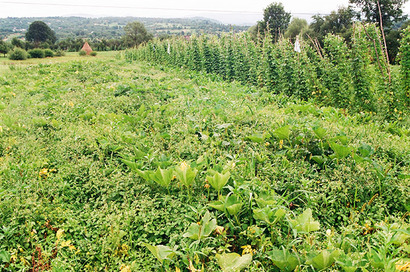
Perhaps the trend to row-cropping cabbage and onions that Jenks mentions in particular spread regionally, first here then there, and elsewhere maybe much later?
In any case we see the influence growing cities had on agriculture: merchants increased their trade in high-tier farm goods, which was motivation for regional specialization. Apple production concentrated in the Breisgau, on Lake Constance and around Frankfurt/Main, cherries near St. Goar and Koblenz, chestnuts by Trier (as early as 1138), almonds at Speyer, walnuts along the Mosel River.
In any case we see the influence growing cities had on agriculture: merchants increased their trade in high-tier farm goods, which was motivation for regional specialization. Apple production concentrated in the Breisgau, on Lake Constance and around Frankfurt/Main, cherries near St. Goar and Koblenz, chestnuts by Trier (as early as 1138), almonds at Speyer, walnuts along the Mosel River.
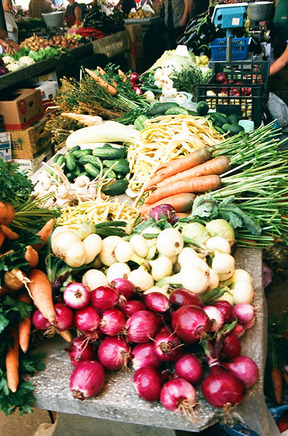
Early industrialization also steered agricultural development. We hear of hemp and flax production increases near textile manufacturing centers, as well as expansion of crops raised for dyeing: Krapp, i.e., Rubia tinctorum, also called “rose madder,” and Waid, “woad,” Isatis tinctoria, a brassica used for blue textiles, became regionally important in southern Germany.
And, so Jenks, we observe the end of the ubiquitous vineyard. No longer do farmers everywhere raise wine grapes – how tart most of the early medieval wines must have tasted! Instead, regular wine industries establish themselves in areas where climate and soils are particularly suited to the grape.
In addition, beer brewing is on the upswing now, so hop yards grow (hops, by the way, initially were used in beer brewing less for aroma than as preservative). Hop yards, however, do not fall in the regionally specialized agriculture category, because beer prices never climbed to where it paid to ship beer over long distances; thus medieval hop yards are recorded by Köln, Hamburg, Bremen, Einbeck, but not in Bavaria – Jenks can not forego this dig –, “not until the end of the Middle Ages did Bavaria become the pronounced Beer Country.”
With the cities achieving their own Kommunen, those city governments become an added layer to which farmers had to contribute financially, by toll, fee, tax. In two centuries the city market quotas rise from an average 5 percent to 12 to 15 percent.
On the other hand, landlords lose some of their hold on farm ground, Jenks points out, especially where farmers clear forest without the landlord’s knowledge and permission. Apparently this happened rather frequently in that era, an unbridled agricultural expansion which, in part, accounts for the diversity in new village scapes. “At some point the distance to their (new) fields seemed too far, which is when they founded a new settlement.”
Jenks sums up: “Agrarian freedoms increased during the High Middle Ages.”
And, so Jenks, we observe the end of the ubiquitous vineyard. No longer do farmers everywhere raise wine grapes – how tart most of the early medieval wines must have tasted! Instead, regular wine industries establish themselves in areas where climate and soils are particularly suited to the grape.
In addition, beer brewing is on the upswing now, so hop yards grow (hops, by the way, initially were used in beer brewing less for aroma than as preservative). Hop yards, however, do not fall in the regionally specialized agriculture category, because beer prices never climbed to where it paid to ship beer over long distances; thus medieval hop yards are recorded by Köln, Hamburg, Bremen, Einbeck, but not in Bavaria – Jenks can not forego this dig –, “not until the end of the Middle Ages did Bavaria become the pronounced Beer Country.”
With the cities achieving their own Kommunen, those city governments become an added layer to which farmers had to contribute financially, by toll, fee, tax. In two centuries the city market quotas rise from an average 5 percent to 12 to 15 percent.
On the other hand, landlords lose some of their hold on farm ground, Jenks points out, especially where farmers clear forest without the landlord’s knowledge and permission. Apparently this happened rather frequently in that era, an unbridled agricultural expansion which, in part, accounts for the diversity in new village scapes. “At some point the distance to their (new) fields seemed too far, which is when they founded a new settlement.”
Jenks sums up: “Agrarian freedoms increased during the High Middle Ages.”
*****
Where can we leave Lentz? The uprise of cities was uneven progress. As were medieval agricultural advances and expansions. Like a tie-dye with the colors running.
In a restaurant at Worms, Lentz has a dessert which could rate a culinary euphemism of Middle Muddle, though first she orders an Apfelstrudel. But Apple Strudel is boring, the chef tells her personally. OK, she’ll try the other locally traditional dish. It’s hot pear slices in a sauce of caramelized brown sugar and black pepper, yes, black pepper; the accompanying scoop of vanilla ice cream is crowned with balsamic vinegar, yes, vinegar. Lentz says that it tastes rather fine, actually.
In a restaurant at Worms, Lentz has a dessert which could rate a culinary euphemism of Middle Muddle, though first she orders an Apfelstrudel. But Apple Strudel is boring, the chef tells her personally. OK, she’ll try the other locally traditional dish. It’s hot pear slices in a sauce of caramelized brown sugar and black pepper, yes, black pepper; the accompanying scoop of vanilla ice cream is crowned with balsamic vinegar, yes, vinegar. Lentz says that it tastes rather fine, actually.
© 2014 Lentz Spelt Farms
- Sources: Von den Archaischen Grundlagen bis zur Schwelle der Moderne, Stuart Jenks; Das Mittelalter, Becksche Reihe: Philippe Aries / Evamaria Engel / Horst Fuhrmann / Werner Rösener / Peter Blickle / Heide Wunder *
| rise_of_cities.pdf |

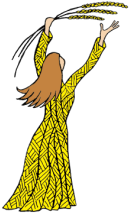
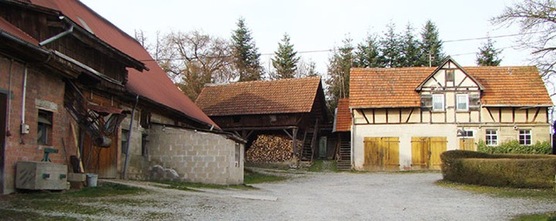
 RSS Feed
RSS Feed